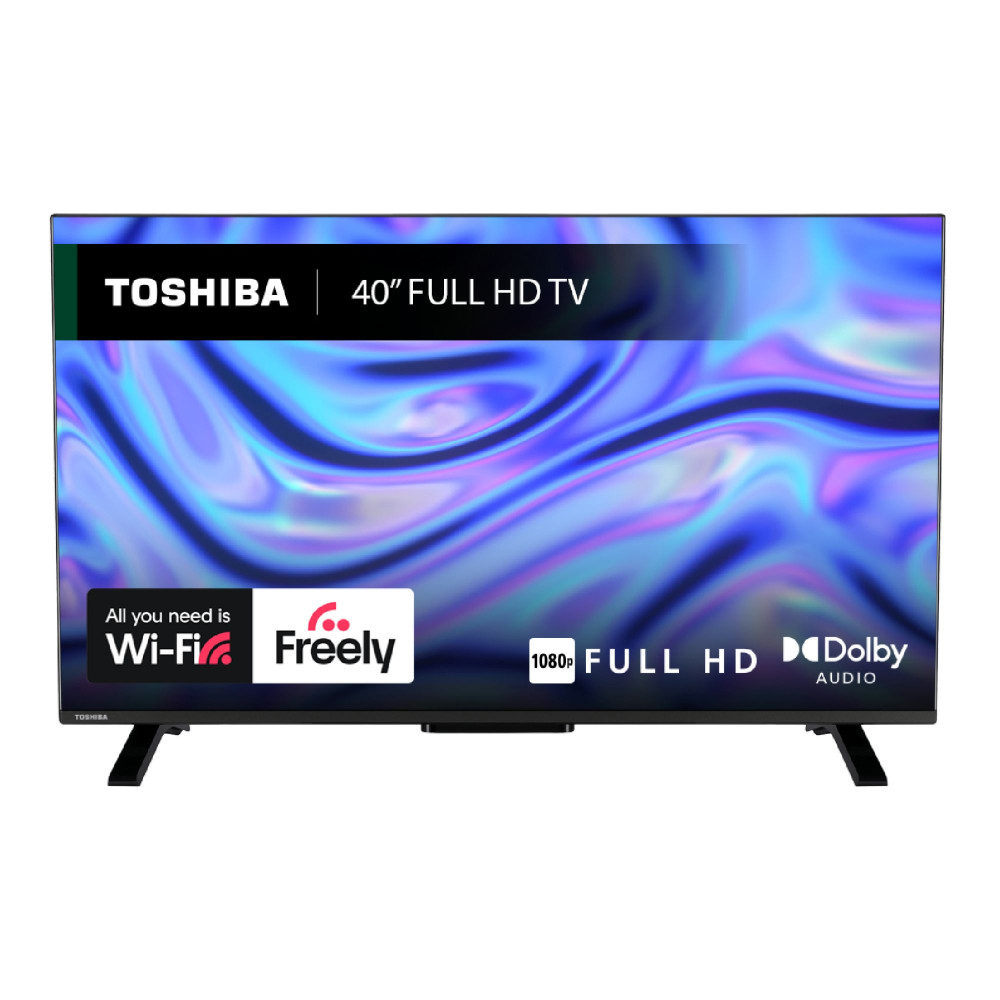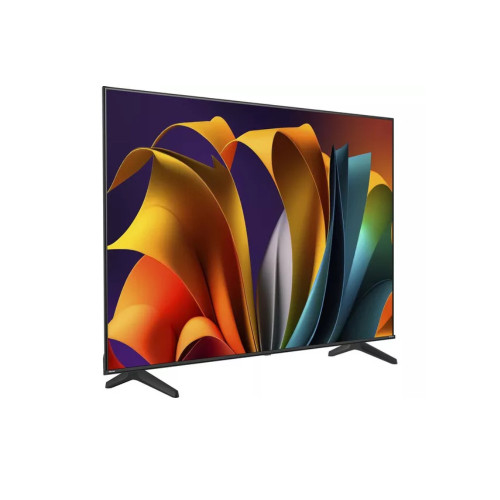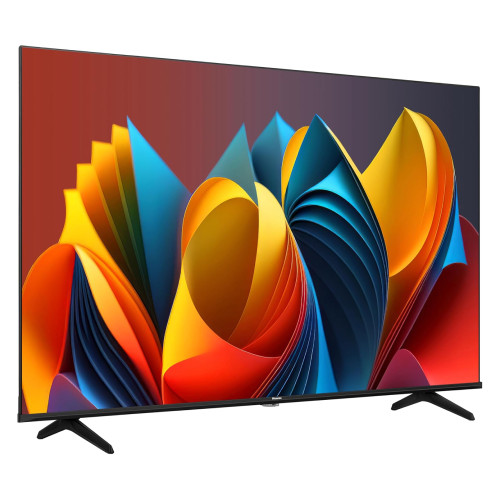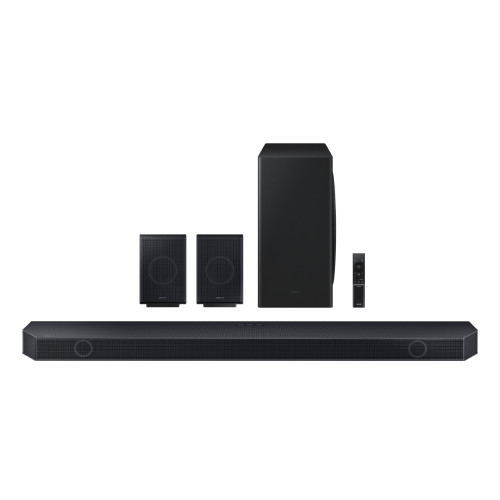POSTED: 21 March, 2025
Ultimate TV Buying Guide: What to Look for in a TV
No more TV confusion! Your ultimate TV buying guide is here!
Ever felt lost in a sea of TV specs? OLED, QLED, 4K, 8K... it’s enough to make your head spin. But you aren’t alone!
Yes, the TV market can be overwhelming, with so many options to choose from, but choosing a new TV should be exciting, not stressful. If you’re new to the expansive world of modern TVs or find yourself confused by terms like OLED, QLED, 4K, and 8K, this TV buying guide is for you. We’ll guide you through everything you need to know, helping you cut through the jargon and discover the ideal TV for your home.
Think of your TV as the heart of your home entertainment. It's where you'll gather for movie nights, cheer on your favourite teams, and dive into immersive gaming worlds. Choosing the right one can make all the difference. So, let’s clear up the confusion and help you pick the best one for your needs.
TV Buying Guide: Everything You Need to Look for In Your Next TV
TV Types and Display Technologies
Confused between Q LED vs OLED or unsure between 4K vs QLED TVs? You won’t be for long. Before we dive into this TV buying guide, let’s first explore the most common TV types and display technologies to help you navigate the diverse TV market.
| TV Type/Display Technology | Use/Benefit |
|---|---|
| LED (Light Emitting Diode) | Most common TV type. Uses an LED backlighting behind an LCD panel. Affordable but basic (lacks deep blacks and high brightness). |
| LCD (Liquid Crystal Display) | The foundation of LED TVs. All LED TVs are technically LCD TVs but with LED backlights instead of CCFLs (Cold Cathode Fluorescent Lamps). |
| QLED (Quantum Dot LED) | Better than LED TVs, with a quantum dot layer that enhances colour and brightness. Great for bright rooms but doesn’t achieve perfect blacks like OLED. |
| OLED (Organic Light Emitting Diode) | Each pixel emits its own light, allowing true blacks and infinite contrast. Best for cinematic visuals but can be expensive and less bright than QLED. |
| QNED (Quantum NanoCell LED) | Combines Quantum Dot and NanoCell technology for richer colours and brightness. Mini-LED backlighting improves contrast and deeper blacks. Bridges the gap between QLED and OLED at a lower cost. |
| Mini LED | Uses thousands of smaller LEDs for more precise local dimming and better contrast than standard LED TVs. A middle ground between QLED and OLED in terms of performance. |
| Micro-LED | Advanced LED technology with self-emissive pixels, similar to OLED but brighter and more durable. Still very expensive and mainly used in premium, large-screen TVs. |
| Projectors | Not a traditional TV but used in home theatre setups. |
| HDR (High Dynamic Range) | Enhances brightness, contrast, and colour depth for lifelike images with deeper blacks and brighter highlights. Widely used in movies, TV, gaming, and live broadcasts. |
| HDR10 | A standard HDR format that enhances brightness, contrast, and colour depth. Supports up to 10-bit colour for richer visuals in movies, TV, and gaming. |
| Hybrid Log-Gamma (HLG) | Designed for live TV and sports broadcasts, developed by BBC & NHK. No metadata required, allowing seamless compatibility with SDR and HDR TVs. Ideal for broadcast television and satellite TV rather than streaming or Blu-ray content. |
| Smart TVs | Feature built-in Wi-Fi & streaming apps (Netflix, YouTube, Disney+, etc.). Support internet browsing, screen mirroring, and app downloads. Receive firmware updates for new features and improvements. |
| Voice-Assistant TVs | Offer hands-free control via Google Assistant, Alexa, or Siri. Use voice commands for channel changes, volume, and smart home control. Provide voice navigation, reminders, and personalised recommendations. |
Determine the Purpose of Getting the TV
Next, it’s important to assess your needs and determine how to choose a TV that best suits your lifestyle, whether it’s for entertainment, sports, or gaming. Understanding your primary use will help you choose a TV with the right features while ensuring you get the best value for your budget.
Here’s what to look for when choosing a TV for your specific purpose
| Entertainment (Movies, TV Shows, Streaming) | Sports (Fast Action, Bright Environments, Group Viewing) | Gaming (Console & PC Gaming, Competitive Play, Smooth Gameplay) | |
|---|---|---|---|
| Recommended Screen Size | 55-inch or larger – 65-inch + for home theatres | 55-inch or bigger (depending on your viewing distance) | 42-inch – 65-inch (depends on desk vs. couch setup) |
| Resolution | Recommended: 4K UHD (3840 x 2160). 8K (7680 x 4320) is an option but content is limited. | 4K UHD (3840 x 2160) | 1080p (Full HD) (for budget gaming), 4K UHD and 8K for higher-end gaming |
| Refresh Rate | 60Hz (sufficient for most content), 120Hz (beneficial for smoother motion, specifically in fast-paced scenes) | 120Hz or more | 60Hz-240Hz |
| Display Technology | Best choice: OLED Alternative: Mini-LED or QLED |
Best Choice: QLED or Mini-LED Alternative: OLED |
Best Choice: OLED Alternative: Mini-LED or QLED |
| Audio | Look for Dolby Atmos support and built-in subwoofers. External soundbars/home theatres are recommended. | Dolby Atmos, AI sound processing, or an external sound system is recommended. | Most built-in TV speakers are average. External speakers or gaming headsets are recommended. |
| Connectivity | HDMI eARC, Wi-Fi 6/Ethernet | Multiple HDMI ports for streaming devices and cable boxes. Ethernet or strong Wi-Fi for live sports streaming. | HDMI 2.1 is a must (for 4K 120Hz, VRR, and ALLM), USB ports for gaming accessories. |
| Smart Features | WebOS (LG), Tizen (Samsung), or Google TV with built-in streaming apps (Netflix, Disney+, etc.) | HLG (Hybrid Log Gamma) for live broadcasts, Motion Smoothing for fast-action scenes. | Game Mode, VRR (G-Sync/FreeSync), Auto Low Latency Mode (ALLM). |
| Additional Features | Dolby Vision, HDR10+, Filmmaker Mode | HLG for sports broadcasts, Motion Interpolation for smoother playback. | HDR10, Dolby Vision Gaming, VRR. |
10 Essential Things to Check/Look for When Buying a TV
You’ve figured out what you’ll be using your TV for, and you know the difference between OLED and QLED. Now it’s time to dig into the details that will truly make or break your viewing experience. This section of our TV buying guide/TV purchase guide will walk you through the essential things to check before buying a TV, ensuring you get the best performance and value for your money, whether you're eyeing the best 4K TVs or the top rated smart TVs.
Screen Size
When buying a TV, screen size is one of the most crucial factors to consider. Take the screen size as the perfect pair of shoes, they have to fit just right! Too big, and you’ll feel overwhelmed; too small, and you’ll miss the detail.
No matter if you’re looking for the best budget TVs or the best TVs to buy overall, selecting the right size ensures an immersive viewing experience without straining your eyes.
Many people prefer 65” to 77” TVs for a great movie experience at home. On the other hand, gamers often choose 42” to 48” TVs to reduce eye strain, though larger sizes are still popular for console gaming. For those on a budget, the best budget TVs in the 50-55 inch range offer excellent value with 4K resolution and HDR support. If you're looking for the best TVs to buy, upgrading to a 65-inch or larger OLED or QLED model can provide a more cinematic experience with superior contrast and colour accuracy.
How to Measure a TV and Determine the Right Size
TVs are measured diagonally from corner to corner. However, bigger isn’t always better—you should also consider how far you’ll be sitting to get the best mix of screen size and comfort.
Recommended Viewing Distance Based on TV Screen Size
| Screen Size | Recommended Viewing Distance |
|---|---|
| 32 Inch | 1.1 m (3.5 ft) |
| 43 Inch | 1.4 m (4.5 ft) |
| 50 Inch | 1.5 m (5.0 ft) |
| 55 Inch | 1.7 m (5.5 ft) |
| 65 Inch | 2.0 m (6.5 ft) |
| 75 Inch | 2.3 m (7.5 ft) |
| 85 Inch | 2.6 m (8.5 ft) |
| 98 Inch | 3.0 m (9.8 ft) |
Display Technology
We’ve already touched on TV types and display technologies in the earlier sections of our TV buying guide.
Understanding TV types, such as OLED TVs, QLED TVs, energy efficient TVs, smart TVs, and display technologies is critical to choosing the right TV for your home.
For your convenience, here’s a quick breakdown.
- LED (Light Emitting Diode): Budget-friendly, widely available.
- QLED (Quantum Dot LED): Brighter colours, better HDR, good for bright rooms.
- OLED (Organic LED): Deep blacks, superior contrast, best for cinematic experience.
- Mini-LED & Micro-LED: More dimming zones, higher brightness, improving LED performance.
Resolution: 4K, 8K, 1080P: What It Means for Your TV
Resolution means the number of pixels on your screen. The more the pixels, the sharper the picture.
Modern TVs typically have the following resolutions:
1080p Full HD (1920 x 1080 pixels) - The classic but ageing option
4K Ultra HD (UHD) (3840 x 2160 pixels) - Offer the best balance of price and picture quality.
8K Ultra HD (7680 x 4320 pixels) - Amazing detail but requires a premium investment.
Full HD screens are now somewhat ageing tech and outdated, mainly reserved for the smallest and most affordable models. 4K Ultra HD offers the ideal balance of price and picture quality, making it the best option for most users. 8K resolution offers mind blowing detail, but it’s currently available on expensive, big-screen TVs with little native content available. That means most of what you watch will be upscaled rather than true 8K.
If you’re investing in an 8K TV, go for a more premium model from a trusted brand, like the Samsung 85” QN900D 8K UHD Neo QLED Smart TV. Samsung has consistently listed among the best TV brands and ranked as one of the top rated TV brands, standing out for its innovative features and wide range of options.
Refresh Rate & Motion Handling
Refresh rate and motion handling are essential for gaming and sports fans.
The refresh rate in TVs, measured in Hertz (Hz), indicates how many times per second the screen updates its image.

[Image sourced from samsung.com]
In TV refresh rates, the common debate is 60Hz vs. 120Hz vs. 144Hz- which delivers the most fluid motion. As with TV resolution, a higher refresh rate in TVs results in more seamless movement, enhancing fast-paced action and gaming.
60Hz- Standard for budget and mid-range TVs. Ideal for movies and casual viewing.
120Hz+ - Great for sports and gaming.
144Hz- Found in high-end gaming TVs and monitors, offering ultra-smooth gameplay.
As a next-gen gamer, you must also look for VRR (Variable Refresh Rate), HDMI 2.1, low input lag, and fast response time in your TV.
HDR (High Dynamic Range)
If you’ve ever explored TVs, you must have come across the term HDR.
HDR (High Dynamic Range) is a key factor that determines picture quality. It enhances the contrast and colour range of a TV, providing a more realistic and vibrant picture.

[Image sourced from global.hisense.com]
Essentially, HDR allows for brighter highlights and deeper blacks, revealing more detail in both bright and dark scenes. This results in a more immersive viewing experience, particularly noticeable on the best 4K TVs.
Different HDR Formats and Their Meaning
HDR10 (Standard HDR)- Most common HDR format, used in most TVs, streaming platforms, and gaming.
HDR10+ and Dolby Vision- Best for movies, featuring dynamic metadata to adjust HDR effect scene-by-scene for enhanced accuracy.
HLG (Hybrid Log-Gamma)- Designed for live TV and broadcast content, ensuring compatibility with both SDR and HDR displays.
When selecting a TV, consider which HDR format it supports. Dolby Vision and HDR10+ often provide the most visually compelling experience.
Smart TV Features & Operating Systems
You've considered picture and motion, but what about the 'smart' side of your TV?
In this part of our TV buying guide, we will break down popular smart TV platforms, streaming app options, and the difference between ad-supported vs premium smart TVs, helping you pick the best one for your needs.
If you’re choosing a Smart TV, consider the following factors:
Operating System
- Look for Android TV / Google TV if you need versatility, access to a wide range of apps, and Google Assistant integration.
- Go for webOS (LG) if you prefer a user-friendly interface, smooth performance, and strong app support.
- Opt for Tizen (Samsung) if you want a fast, intuitive OS with a clean layout but are okay with fewer apps than Google TV.
- Roku TV / Fire TV / Apple TV integration if you love streaming, want a simple interface, and prefer a budget-friendly option.
Streaming App Compatibility
Make sure the TV supports your favourite streaming apps like Netflix, Disney+, Prime Video, and YouTube.
Voice Assistants & Smart Home Integration
If you use Alexa or Google Assistant, check if the TV supports them for smart home integration and hands-free control.
Ad-Supported vs. Premium Smart TVs
Ad-supported Smart TVs- Have lower upfront costs but display ads.
Premium Smart TVs- Have a higher cost but offer ad-free navigation and sometimes extra features.
Connectivity – Ports and Wireless Features
When getting into TV buying, don't just get caught up in the screen size and fancy picture tech – you've got to think about Connectivity (Ports and Wireless Features). Trust me, you'll thank yourself later when you're not scrambling for an extra HDMI port or dealing with spotty Wi-Fi during movie night!
- Essential Ports to Look For: HDMI 2.1 (crucial for next-gen gaming and future-proofing), USB (handy for external storage and media playback), Optical Audio, Ethernet, ARC/eARC for seamless soundbar integration.
- Key Wireless Features: Wi-Fi 6, Bluetooth, Chromecast and AirPlay compatibility.
Audio Quality & Sound Systems
Though it's always convenient to have a TV with built-in speakers, they are not always sufficient. This is because they typically lack depth and power. For an immersive sound experience, external audio is recommended.
In 2025, we have exceptional audio-quality TVs and sound systems, including soundbars for TVs such as the Sony BRAVIA Theatre Bar 9, Samsung HW-Q930D, and Sony BRAVIA Theatre Bar 8.
If you’re looking for the best audio equipment for TVs, consider one with Dolby Atmos & DTS:X support. Soundbars that support both Dolby Atmos & DTS: X are LG US70TY Dolby Atmos Sound Bar for TV, Sony Bravia Theatre Bar 8 HTA8000 Soundbar, and Sony HT-S2000 Dolby Atmos Soundbar.
For external audio, one of the best ways to go is a sound bar but the option of home theatre is also there. Ultimately, soundbar vs. home theatre comes down to your budget.
If you’re on a budget: Soundbars significantly enhance audio quality and are often included in smart TV deals.
If you’re not on a budget: Home theatre systems deliver the most immersive experience, but at a higher cost.
AI Processing: Smart Optimisation for Stunning Results
Viewers with large libraries of older content, those seeking the best possible picture quality, regardless of the source, and gamers wanting smoother upscaling can benefit from AI processing in modern TVs.
With AI processing, the TV intelligently adapts to every scene, transforming standard content into near-4K quality, making it a key factor in selecting the right TV. AI processing also optimises sound quality, complementing the best soundbars for TV and future-proof your TV against evolving content standards. Few top TVs with AI processing are the LG OLED Evo C4 Smart TV, Samsung QN90D, and Samsung S90D.
Dimming
Dimming enhances contrast for lifelike images, specifically in dark scenes. It can be specifically valuable for movie lovers.
Wall Mounting
Try getting a TV that supports wall mounting, as wall mounting frees up space and adds a clean aesthetic. Prioritise VESA support for easy setup.
Budget Considerations and Value
No TV buying guide is complete without considering your budget and identifying the best value options. Here’s what you can expect from different price ranges in 2025.
Budget (<£500):
- Expect basic LED TVs, often with 1080p resolution or entry-level 4K models. Good for casual viewing.

Mid-Range (£500-£1500):
- Offers QLED and OLED options, 4K HDR, and improved processing. These TVs balance features and price, making them ideal for most users.

Best Value for Money
To get the best value for your money, carefully weigh a TV’s features against your budget. Mid-range TVs often provide the best balance of quality and affordability, making them a great choice for the average user.
To maximise your investment, don't get distracted by every bell and whistle. Ask yourself, 'will I actually use this?' and let that guide your decision.
Best TV Brands
While many TV brands are available, only the best TV brands offer top-tier quality and performance. Choosing the right one depends on your needs—whether you're looking for the best budget TVs, top rated smart TVs, or energy efficient models.
That said, here’s a look at the top TV brands in 2025.
Top TV Brands in 2025
- Samsung TVs: Best for QLED, Neo QLED, and smart TV features.
- LG TVs: Best for OLED TVs & webOS smart features.
- Sony TVs: Best for picture quality, gaming, and high-end processing.
- Hisense TVs: Best for affordable 4K TVs and good features.
If you're looking for the best TVs to buy for 2025, focusing on QLED vs OLED is crucial. QLED TVs offer brighter screens for well-lit rooms (read more about the best TVs for bright rooms here), while OLED TVs provide deeper blacks for cinematic viewing.
Where to Shop TVs in the UK
You can shop for TVs online or in-store in the UK. However, many prefer buying online due to a wider selection, greater convenience, more discounts, and better smart TVs deals.
Your Perfect TV Awaits- Shop TVs Online at Box.co.uk
We hope our TV buying guide has helped you feel confident in choosing the best TV for your needs.
If you've decided on a specific model, find and shop it at Box.co.uk, where you'll discover a wide selection of TVs, featuring the best 4K TVs, top rated smart TVs, stunning QLED TVs, and more—all at competitive prices. We also offer a comprehensive selection of the best soundbars for TVs, ensuring an unrivalled audiovisual experience.
Our selection includes TVs from top brands like Samsung, Sony, Hisense, and LG, ranging from affordable 4K TVs to premium OLED and QLED models, as well as smart TVs and various other options, catering to every budget and preference.
Beyond our extensive range, we offer exclusive deals, expert advice, fast delivery, and excellent customer service for a seamless shopping experience. Explore Box.co.uk’s TV and Audio Store today to discover the best 4K Ultra HD TVs, smart TVs, QLED TVs, OLED TVs, and much more!
Conclusion
Choosing the right TV can be overwhelming with the wide range of options available, but by understanding key factors such as screen size, resolution, refresh rate, display technology, and smart features, you can make an informed decision that best suits your needs.
Whether you're looking for a budget-friendly TV, a premium OLED for cinematic visuals, or a high-refresh-rate display for gaming, there’s a perfect TV for you.
When deciding between Q LED vs OLED, consider your viewing environment—QLED TVs are ideal for bright rooms, offering vivid colours and high brightness, while OLED TVs provide deep blacks and superior contrast, making them terrific for movies and darker settings. If you’re looking for the best 4K TVs with great performance, brands like Samsung, LG, Sony, and Hisense offer a mix of affordability and high-end features.
Additionally, pay attention to screen size, resolution, refresh rate, smart features, audio quality, and other important factors (AI processing, dimming, wall mounting compatibility) to ensure you get an unbeatable TV. While there are many TV brands on the market, the best TV brands remain Samsung, LG, Sony, and Hisense.
If you want to shop TVs online in the UK, explore Box.co.uk. Box.co.uk offers a wide selection of top rated smart TVs, including 4K Ultra HD TVs, energy efficient TVs, QLED TVs, OLED TVs, and more at competitive prices, along with expert advice, exclusive deals, and fast delivery. Besides being a leading destination for those looking for the best TVs to buy in 2025, we also offer great smart TV deals, discounts, and other special offers to help you save on your purchase. Browse our extensive range today and find the ultimate TV from top rated TV brands to elevate your home entertainment setup!
FAQs
What should I look for when buying a TV?
When buying a TV, focus on factors like screen size, resolution, and refresh rate. A TV buying guide can greatly assist in helping you make the right decision.
Which is better, LED or 4K TV?
4K describes resolution, LED is backlighting; the best 4K TVs typically use LED, offering far more detail than standard LED TVs.
What kind of specification should you look for in a new TV?
For a new TV, prioritise 4K resolution, a 120Hz refresh rate, HDR, HDMI 2.1 for gaming, and smart features for streaming.
How to tell the quality of the TV?
TV quality is evident in clear colours, deep blacks, and smooth motion. Reviews of top rated smart TVs and good contrast are key indicators.
What’s the best TV for dark rooms?
OLED TVs are the best choice for dark rooms due to their perfect blacks and infinite contrast. High-end LED TVs with full-array local dimming, especially Mini-LED models, are also strong alternatives, offering improved contrast and brightness.
How to choose a TV for my budget?
To choose a TV within your budget, focus on the features that matter most to you and compare options in your price range. Smart shopping and great deals make the buying process even easier!


